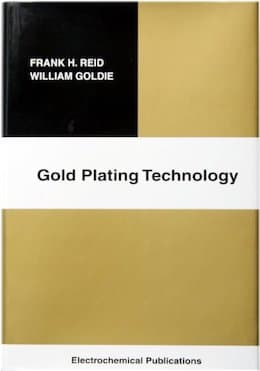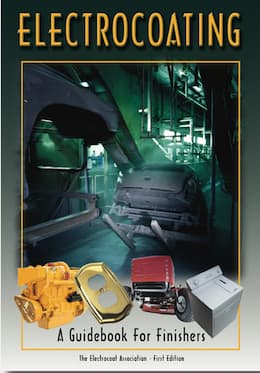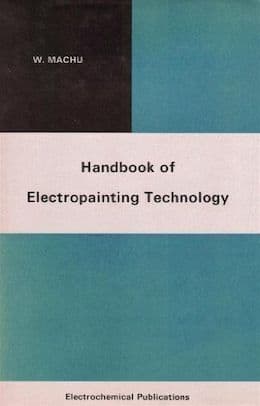
-----
Gold plating rubs right off!
Q. I have applied 24k gold plating using cyanide bath. Time of plating was 15 seconds at 3,9 volt. Plating is rubbing off and steel surface is visible after shedding of gold plating on ring.
imran khan- lahore pakistan
January 27, 2023
by Reid & Goldie
-- hard to find & expensive; if you see a copy cheap, act fast!

on eBay or Amazon
or AbeBooks
(affil link)
A. Hi Imran Khan. Are you sure the ring is made of steel? That is a very unusual material to make rings or other jewelry from.
Are you sure the ring is not nickel plated or white bronze plated -- gold will usually have no shine if deposited on a matte surface like steel. Perhaps the ring is made of silver or stainless steel?
15 seconds will not be much gold (do you have a target thickness?); poster Rajan Parekh reports below that he plates jewelry for 25-30 seconds and it wears away in 30-40 days. Rings are very high wear things, so the gold should be expected to wear away rather quickly from a ring ... I'm not quite sure if you are saying that it wears away too quickly or it has no adhesion to the substrate.
It will be easier to help you if you will take the time to introduce yourself and your situation. Can you estimate the surface area of the ring and/or advise the amperage applied so we can estimate the thickness? Thanks!
Luck & Regards,

Ted Mooney, P.E. RET
Striving to live Aloha
finishing.com - Pine Beach, New Jersey
Ted is available for instant help
or longer-term assistance.
⇩ Related postings, oldest first ⇩
Q. Hello all,
I had some silver medallions/tags cast for making engraved bracelets, and then had some of them rhodium plated and others gold plated (18k I was told).
I had read somewhere that the plating should be 3 microns thick to be lasting but I don't know of any way to measure the layer after the process. Anyway, I started rubbing one of the gold plated medallions with a silver cleaning cloth, and the plating came off in 15-20 seconds!
Is that normal? Obviously you shouldn't clean a plated medallion with that kind of cloth, but still... I did the same thing with a gold plated brass medallion I had bought and it didn't rub off.
Q1. How can I obtain a better plating quality?
Q2. I read it depends mainly on 2 factors: the amount of gold in the bath, and the duration of the bath. What is the quantity and duration required to get a plating that is at least 1 micron thick?
Q3. Is there any way to test the quality of the plating?
Q4. Will applying some kind of coating over the plating increase its longevity?
I really hope someone will be able to help me,
Thanks a lot
designer - Seoul, South Korea
December 31, 2009
A. Dear Sebastian,
A1: You should have a method for good base metal preparation and activation of your items to be plated. Here one of the reason though not major can be of lack of adhesion but not a major reason.
A2: The amount of gold in the bath, nor the duration of the bath is not the problem in your case. It is outright cheating by your plater(if you asked him to plate 1 micron). One micron gold per 100 sq. cm (1 dm sq.) should weigh 175-178 mg. gold. The plater did only a flash plating.
A3: In your case you can use an electronic weighing machine. Wt of item (dried) before gold plating = A; wt. after plating gold(dried) = B. Wt of Gold = (B-A)=C
A4: You can have electrophoretic lacquer coat or dipping lacquer applied and backed.
Regards

T.K. Mohan
plating process supplier - Mumbai, India
|
|
A. Sebastian, Fellow Plater - Syracuse, New York, USA A. Cleaning the surface is definitely key but after that is done there may be more you can do. - Oshawa, Ontario, Canada |
A. Hi,
I would suggest you to go for an hard gold bath or for an gold forming bath to plate 3 microns, the hard gold deposit will not have a very good colour (like 23 or 24k) but then you can have a flash of the desired colour you need.
Then a topcoat of spray or electrophoretic lacquer will help on for longer protection.
Best Regards

Praveen Kumar
plating process supplier
Mumbai, India
|
|
Q. Hello. I have a question about silver plated jewelry. Is .2 micron plating with e-coating sufficient as far as durability? I have been told that it "passes a 72 hour salt spray test". If this will quickly rub off, what should be the thickness for silver plating and how can it be verified? Thanks! Brenda Ross- Los Angeles, California, USA August 3, 2012
"Electrocoating: a Guidebook for Finishers"
by Electrocoat Association  on eBay or Amazon or AbeBooks (affil link) A. Hi, Brenda. It is the e-coating / clear coating that is passing the salt spray test, not the silver plating. And the silver won't quickly rub off because it is not exposed to the rubbing; it is underneath that clear coating. 0.2 micron gold plating plating would be reasonable on costume jewelry but is awfully thin for silver plating (8 millionths of an inch). If you had a single ring with 1/16" thick silver plating on it, it would have as much silver as 7,800 rings with this thickness of plating.
I think that either I am misunderstanding you, or you are misunderstanding someone else, because it just doesn't make much sense: It seems very unlikely that someone would make rings and then focus their efforts upn reducing the thickness of the silver so there was only 1/100 cent worth of silver on them instead of a 1/10 cent worth :-) You asked how the thickness can be verified but please introduce yourself so we can be more helpful. If we start discussing $45,000-$60,000 instruments that can make a lot of sense if you are a manufacturer; but if you are a hobbyist or a consumer buying a $15 ring, it doesn't. What is your involvement in the subject please? Thanks! Regards,  Ted Mooney, P.E. Striving to live Aloha finishing.com - Pine Beach, New Jersey Ted is available for instant help or longer-term assistance. Q. Ted, - Los Angeles, California August 6, 2012 A. Hi again. Yes, I was misunderstanding you: necklaces are quite different from rings. I still think here is a typo or misunderstanding, as "normal thickness" surely must be 0.2 microns -- I'm pretty confident that .02 microns would not even be visible, and the jewelry would still be brass colored. Again, I don't think the silver thickness will have any bearing on wear resistance, since it is covered by the e-coating. But there is a time-sensitive, temperature-sensitive, materials-sensitive phenomenon called "diffusion", whereby two materials slowly sort of melt together even at room temperature. If the necklace material is copper or brass, and there is no "barrier layer", like nickel, between the copper and silver, those two metals will slowly diffuse, but the thicker the silver, the longer it will be before it's a problem. I don't think most people expect costume jewelry to last a lifetime like precious metal jewelry, so you may be able judge performance from a few pieces in circulation. A peek is worth a thousand finesses. Regards,  Ted Mooney, P.E. Striving to live Aloha finishing.com - Pine Beach, New Jersey Ted is available for instant help or longer-term assistance. |
Multiple threads merged: please forgive chronology errors and repetition 🙂
Flash Gold Plating with Life of 3 months
Q. Hello,
Can anyone suggest the best way to plate the Copper and brass jewellery in economic way, and the plating should last for at least 3 months.
Currently the process we are doing is:
Clean & buff the jewellery, then give copper cyanide flash 6-7 volt for 30-40 seconds, then again clean the jewellery in ultrasonic machine, then after 4 plain water swills then 5% H2SO4 water swill, then again clean water swill; then load the jewellery in Acid Copper bath for 12 minutes at 3 volts - 30 amperes, then after that jewellery gets good shine, then we clean the jewellery again in all earlier mentioned swills and then ultrasonic machine for 3 minutes.
Then we give flash of Yellow bronze at 3.5 volts for 15-20 seconds then, clean again with 2 swills and then again in ultrasonic machine. then finally we give gold flash of 5 grams of GPC (Gold potassium Cyanide) made of 5 ltrs Tank dissolve with 2 cubes of around 100 grams of cyanide and 1 drop of Silver potassium cyanide. We give flash 6-7 volts for 25-30 seconds, then we give 2 swills of clear water then dip the drag-out in Hot water of 85 °C. Then we dip drag out into anti-tarnish tank for 4 minutes then clean in 2 swills and again give dip into hot water and then keep in heater for drying the drag out.
The flash gold jewellery made through this process lasts only for 30-40 days.
We want to last our jewellery for at least 90 days.
Will appreciate if you suggest some other process with chemicals and lacquers that may be available in India which will help to last jewellery for 90 days.
regards
Plating Shop - Mumbai, India
July 22, 2010
A. Hi,
You can go for an electrophoretic clear lacquering process and cure it at 130 °C, you may get a hardness for 4H and a thickness of 4-12 microns, so choose accordingly the thickness and hardness which will not effect your jewelry gold colour and brightness.
Regards

Praveen Kumar
plating process supplier
Mumbai, India
A. Why don't you try to plate with palladium after acid copper and then gold flash.
Artan Refeja- Istanbul, Turkey
Q, A, or Comment on THIS thread -or- Start a NEW Thread
